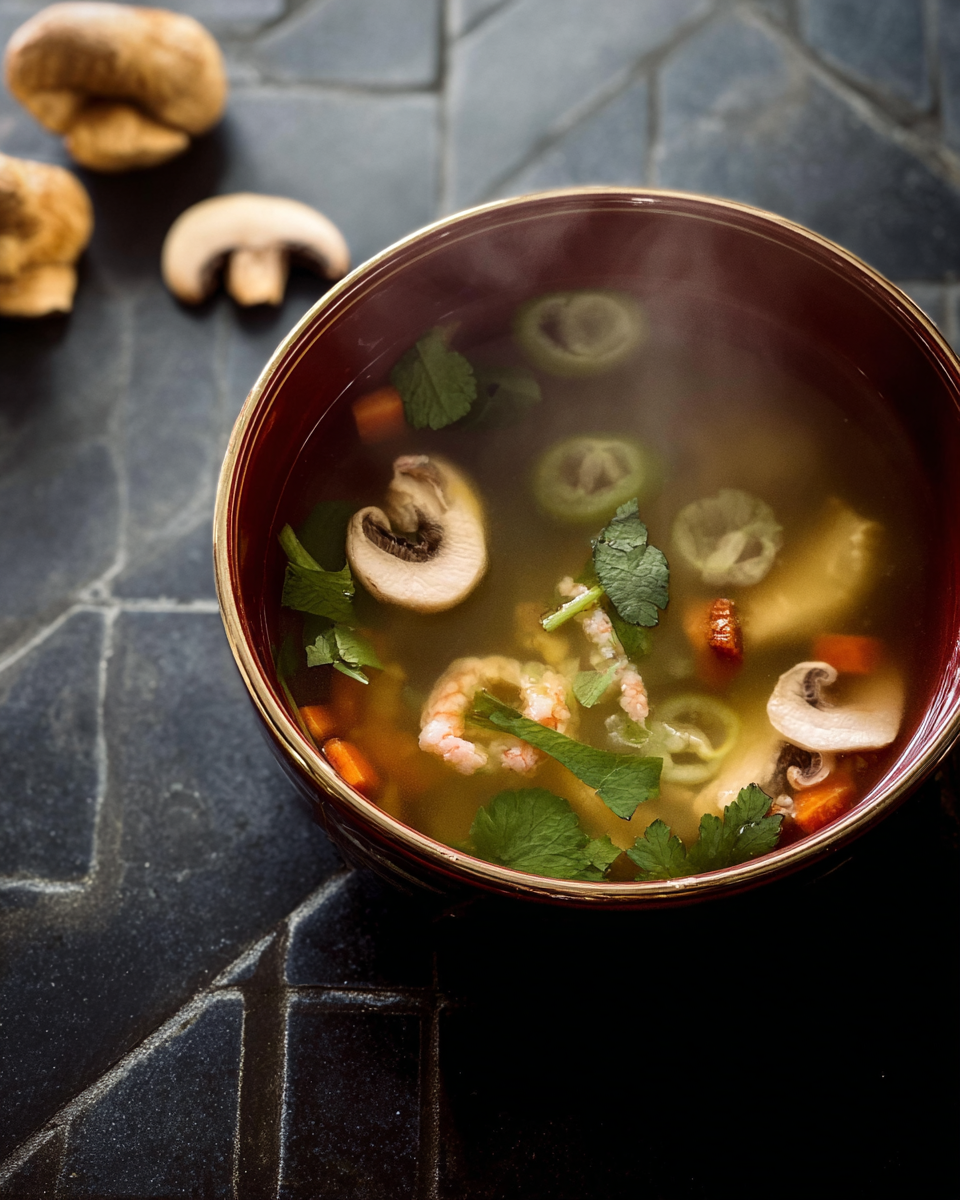The warmth and simplicity of Hibachi Soup make it a beloved starter in Japanese steakhouses around the world. Its clear, aromatic broth, subtly infused with garlic, onion, and soy, serves as a gentle introduction to a flavorful meal. The floating mushrooms and green onions add both texture and beauty to the dish, while the lightness keeps it from ever feeling too heavy. Perfect for chilly evenings or when you want a light, flavorful bite, this soup is as easy to prepare as it is satisfying. Whether you’re recreating the full hibachi experience at home or just want a clean, nourishing bowl of comfort, this recipe delivers. The ingredients are simple, the preparation is straightforward, and the result is restaurant-quality elegance right from your kitchen.
Full Recipe:
Ingredients:
-
4 cups chicken broth (or vegetable broth for vegetarian option)
-
1 cup water
-
1/2 onion, chopped
-
2 garlic cloves, minced
-
1/2 cup carrots, thinly sliced
-
1/2 cup celery, thinly sliced
-
1/2 cup mushrooms, sliced (shiitake or button)
-
1 tablespoon soy sauce
-
1 teaspoon sesame oil
-
2 green onions, sliced thin (for garnish)
-
Salt and pepper to taste
Directions:
-
In a large pot, combine chicken broth and water. Bring to a gentle boil over medium-high heat.
-
Add the chopped onion, garlic, carrots, and celery. Reduce heat and simmer for 20 minutes.
-
Stir in the mushrooms, soy sauce, and sesame oil. Simmer for an additional 10 minutes.
-
Season with salt and pepper to taste.
-
Remove from heat and strain the broth if you want a clearer soup, or serve as is for more texture.
-
Garnish each serving with fresh sliced green onions before serving hot.
Prep Time: 10 minutes | Cooking Time: 30 minutes | Total Time: 40 minutes
Kcal: 60 kcal | Servings: 4 servings
Discovering the Comfort of Hibachi Soup: A Clear, Umami-Packed Japanese Delight
Hibachi Soup, also known as Japanese Clear Soup or Onion Mushroom Soup, is one of those humble yet unforgettable culinary experiences that captivate diners in Japanese steakhouses across the world. Despite its minimalist appearance, this broth-based soup delivers a deeply satisfying, umami-rich flavor that perfectly sets the stage for the bold hibachi entrées that follow. Whether enjoyed as a restaurant appetizer or made in the comfort of your own kitchen, Hibachi Soup is a shining example of how a few simple ingredients can come together to create something soothing, elegant, and nourishing.
In this article, we’ll explore the origins, cultural significance, preparation techniques, health benefits, and creative adaptations of Hibachi Soup. Whether you’re a home cook seeking new inspiration or a food blogger curating content for a wider audience, this guide provides a thorough background to elevate your appreciation and storytelling around this beloved clear soup.
A Peek into the Origins of Hibachi Soup
Hibachi Soup is deeply rooted in Japanese culinary traditions, where clarity and balance in flavor are emphasized. The term “hibachi” originally referred to a portable heating device in Japan, but in Western contexts, it has become synonymous with teppanyaki-style cooking meals prepared on a large, flat iron griddle in front of diners.
Though Hibachi Soup isn’t typically made on the griddle itself, it has become a staple in American-style Japanese steakhouses, where it’s served as a starter alongside salad with ginger dressing. Its flavor base usually includes dashi or broth made from chicken or vegetables, layered with garlic, onions, mushrooms, and other aromatic vegetables, then garnished with sliced scallions or green onions. The final result is a crystal-clear broth that’s simultaneously warming, light, and deeply savory.
Simplicity as the Key to Flavor
What makes Hibachi Soup so remarkable is its simplicity. It requires just a handful of ingredients broth, onions, garlic, mushrooms, and scallions but the technique lies in the careful simmering of these components to coax out their natural flavors. This method of slow infusion ensures that every element contributes to the overall umami profile of the dish.
Unlike creamy or heavily spiced soups, Hibachi Soup relies on a delicate balance. There’s no dairy or thickeners, which makes it ideal for people who are lactose-intolerant, gluten-sensitive (when made with tamari or gluten-free soy sauce), or simply seeking a light, low-calorie meal option. The broth’s clarity and lack of added fats also give it a clean, refreshing finish that doesn’t overpower the palate ideal as an opening act for a multi-course meal.
The Role of Umami in Japanese Clear Soup
One of the cornerstones of Japanese cuisine is the concept of umami, often referred to as the “fifth taste,” after sweet, sour, salty, and bitter. Umami delivers a deep, savory, almost meaty flavor that is the result of naturally occurring glutamates in foods like mushrooms, onions, and soy sauce.
Hibachi Soup is a masterclass in achieving umami without relying on meat-heavy or complex ingredients. The use of mushrooms (especially shiitake), slowly simmered onions, and a splash of soy sauce or tamari transforms a simple broth into a rich, satisfying base that pleases the palate. This makes it especially suitable for vegetarians or those following plant-based diets who still crave that umami depth.
Cultural Relevance and Popularity in Restaurants
Although this soup is commonly associated with hibachi restaurants in the United States, its components and style are deeply traditional. It mirrors osuimono, a class of Japanese clear soups that are commonly served in Japanese households and formal meals. These soups are prized for their elegance and simplicity and often served in lacquered bowls as part of a multi-course meal.
Hibachi Soup’s popularity in Western Japanese restaurants comes from its ability to appeal to a wide audience. It’s mild enough for children and those with sensitive palates, yet flavorful and comforting for seasoned diners. The clear soup also offers a welcome contrast to the bold flavors of teriyaki, fried rice, and grilled meats that follow in a typical hibachi meal.
Why You’ll Love Making This Soup at Home
One of the great things about Hibachi Soup is how easily it translates from restaurant menus to home kitchens. It doesn’t require special equipment, expensive ingredients, or extensive prep time. In fact, it’s often faster to prepare than many Western-style soups, especially since there’s no need for blending or pureeing.
Home cooks also appreciate the adaptability of this recipe. You can modify it to fit various dietary needs make it vegan by using vegetable broth, spice it up with a bit of fresh ginger or chili flakes, or bulk it up with noodles or tofu for a more filling dish. The ingredients are readily available in most grocery stores, and the method is straightforward enough for even novice cooks to master.
Health Benefits of Hibachi Soup
Hibachi Soup offers more than just flavor it brings numerous health benefits to the table:
-
Low in Calories: With minimal oils and no cream, it’s naturally low in calories, making it ideal for those watching their weight or seeking a lighter meal option.
-
High in Nutrients: The vegetables used in the broth onions, mushrooms, carrots, and celery—are rich in vitamins, minerals, and antioxidants.
-
Digestive-Friendly: Thanks to its clear broth and soothing properties, Hibachi Soup can be easy on the stomach, perfect for those recovering from illness or dealing with digestive issues.
-
Immune-Boosting: Garlic and onions are known for their immune-supportive compounds like allicin, and mushrooms bring their own set of immune-boosting benefits.
It’s a comforting, nourishing bowl of goodness that supports wellness without sacrificing taste.
Creative Twists and Variations
Though the traditional version of Hibachi Soup is simple and minimalistic, there’s plenty of room for personalization:
-
Add Protein: Try adding thinly sliced chicken breast, tofu cubes, or even poached shrimp for a heartier version.
-
Go Spicy: Add a few slices of fresh ginger or a dash of chili oil for a warming, spicy kick.
-
Infuse Herbs: A small amount of lemongrass or kaffir lime leaves can bring a Southeast Asian flair to the dish.
-
Noodle It Up: Add cooked soba, rice noodles, or glass noodles to turn it into a light meal.
These additions can turn the soup into a main course while preserving its foundational clarity and umami essence.
Perfect Pairings and Serving Suggestions
Hibachi Soup is best served as an appetizer or light starter before a more substantial meal. It pairs exceptionally well with other Japanese dishes such as:
-
Hibachi chicken or steak
-
Teriyaki-glazed salmon
-
Vegetable tempura
-
Gyoza (Japanese dumplings)
-
Sushi or sashimi platters
-
Stir-fried noodles or fried rice
Its delicate flavor enhances, rather than competes with, these more robust dishes. For a complete Japanese-inspired meal, you could serve the soup with a side of salad topped with ginger-sesame dressing and finish with green tea ice cream or mochi for dessert.
Conclusion:
Hibachi Soup embodies the quiet sophistication of Japanese cuisine. It’s a dish that proves you don’t need a long list of ingredients or complicated steps to create something delicious and memorable. Whether you’re replicating your favorite steakhouse experience at home or simply craving a light, soul-warming soup, this recipe delivers on all fronts.
Its clear, golden broth, aromatic vegetables, and subtle umami flavor make it a standout in any menu. Best of all, it’s endlessly versatile suitable for a wide range of diets and easy to personalize based on your taste preferences. Once you try it, Hibachi Soup is bound to become a staple in your home kitchen. It’s more than just a soup it’s a culinary experience that brings comfort, wellness, and beauty to every bowl.






